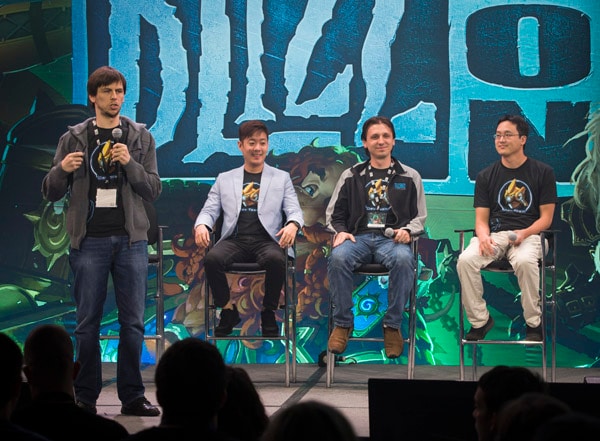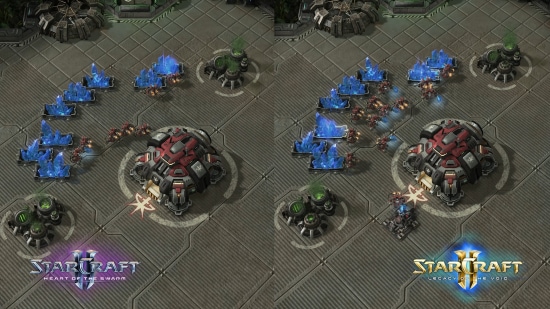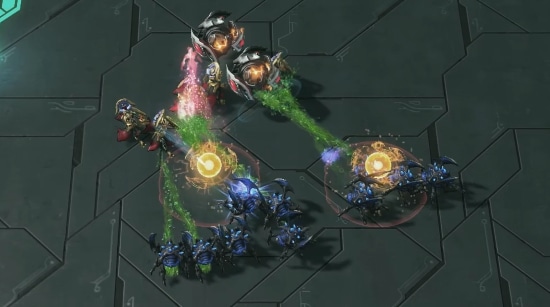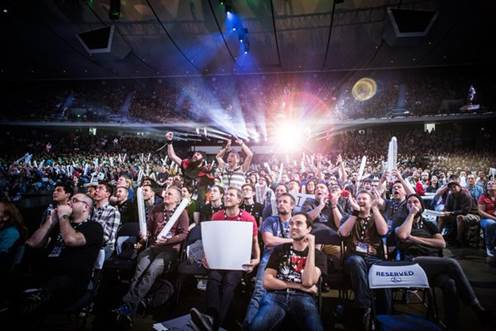StarCraft II: Competitive Multiplayer – Panel Recap
Our StarCraft II Multiplayer Panel just wrapped up at BlizzCon 2015! This panel covered our goals for StarCraft II multiplayer going forward, and also discussed how community feedback has helped shape many of the upcoming changes we have planned.
Below, we’ve included a complete breakdown on everything we discussed in the panel.

Reviewing Multiplayer
Lead Multiplayer Designer David Kim opened up the panel by discussing 1v1 StarCraft II multiplayer and what makes it unique among other game modes like Campaign, Co-op Missions, Archon Mode, and the Arcade. Whereas these other modes are meant to be more accessible to players, 1v1 multiplayer has one of the highest skill-ceilings, if not the highest, of any current game. While we’ve added new game modes that are either collaborative or team-based experiences and serve as excellent areas for more casual players to begin playing StarCraft II, the panel focused more on our goals for improving certain mechanical aspects of the game particularly as it relates to 1v1 multiplayer.
Throughout our multiplayer redesign, we’ve had five major goals:
- More action
- Faster pacing with less downtime
- A balance of micro needs across the races
- Variety in types of micro
- Major redesigns to existing core mechanics
Five Goals for the Future
More action was a core pillar that aimed to promote skirmishes, harassment, and attacks regardless of a player’s unit composition. A great example of this is the new Protoss unit Adept. These units can be built very early on, have the Psionic Transfer ability to quickly move in and disrupt mineral lines of opponents, and can two-shot workers – making them great units to go on the offense from the start of the game. More action is also reflected throughout Legacy of the Void in economic changes, macro changes, and new unit additions.
Faster Pacing birthed the concept of starting with more workers. We wanted to remove periods of the game where players had little opportunity to exert their prowess, and the economic build-up time from 6 to 12 workers was a perfect example of that.

Another desire is for Legacy of the Void to be less about the size of your army and more about engaging frequently and effectively. For this to happen, micro needs to be a vital aspect of all army compositions. To promote this dynamic, we designed units like the Ravager, Disruptor, Adept, and Cyclone. As we added more opportunities to micro with each of the three races, it was important that we made sure the types of micro joining StarCraft II were different enough, while remaining true to the feel of each race.
In addition, we redesigned core aspects of the game. Such changes included revamps to the game’s economy, racial macro mechanics, and all-in strategies. For example, in Legacy of the Void, when a player intends to win solely on the back of a warp-in strategy, it will require a greater investment to achieve the same levels of aggression as in Heart of the Swarm.
While we’ve made many changes in Legacy of the Void, we haven’t made them alone. As Senior Technical Designer Aron Kirkpatrick explained, we’ve had one of the most passionate gaming communities helping us.
The Feedback Process
At the start of our long beta for Legacy of the Void, we began regularly asking players for more feedback. As Kirkpatrick explained during the panel, this made a huge difference in the quality of improvements we made to the game as the beta progressed.
Out of all the games out there, StarCraft II’s community isn’t just passionate—this community pioneered eSports as we know it. Highlighting the competitive aspects of StarCraft II is deeply engrained into the community, and that passion for excellent gameplay was utilized in creating Legacy of the Void through consistently seeking input from our players.
We’re very proud of how our passionate community focuses on constructive feedback and we want to involve them more closely in our development process. With this in mind, Kirkpatrick asked our audience: “how do you get everyone involved in a process as complex as game development?”
Community Informed Design
In designing Legacy of the Void, we became much more transparent. Through sharing our internal design discussions and having more two-way communication, more valuable discussions emerged which significantly improved our development process.
We’ve also held several community summits that have been very helpful in gathering thoughts and sentiments from the personalities and players who represent and advocate for the community.
Harnessing Player Feedback
After gathering and listening to feedback, we began to implement it. The Disruptor, for instance, received a lot of feedback early-on that it was “too binary”; it wildly wiped out an opponent’s army with its attack, or failed spectacularly.

We mentioned in a post that we wanted the unit to survive more but deal less damage, and the community gave amazing feedback resulting in changes. This approach occurred with many other units—even yielding a new unit altogether: the Terran Liberator. As a result of the feedback we received, we feel the Liberator is currently one of the most interesting units in the game.
Large-scale economic changes, as well as changes to Protoss warp-in tactics, were also a result of listening to community feedback. With the community's help, we made additional changes to stabilize the game and make it more fun for everyone.
More Communication Helps
Our macro-mechanics changes were met with mixed-response, yet the community provided consistent feedback as we made adjustments to our approach. We hope the changes we landed on feel more fair as a result of this feedback, and preserve what people like about macro and its importance to high-level play.
Open communication also helped with feedback on early-game army scaling. When we reduced the effectiveness of macro mechanics, this created a more lengthy early game for skirmishes to take place. Most of the feedback we got showed that people enjoyed when skirmishes were frequent but brief, and that this created a better flow through the stages of the game—so we value the feedback we received on this topic.
Aron Kirkpatrick closed by saying that open communication will still continue after launch, but will be focused more on balance than design. Concerning the beta, we achieved a lot thanks to the proactive discussions that took place with the community.

Upcoming Ladder Changes
Next, Game Designer Aaron Larson took the mic to discuss upcoming changes that we’re exploring for the ladder system. He first highlighted how we saw huge benefits from collaborating with the community in the beta, so we want to keep that collaboration going as we develop post-launch features for Legacy of the Void. Right now, we believe we’re in a place where we have a concept that we’d like to reveal and hear your feedback on.
In the past, we’ve seen consistent feedback that players desire more transparency on the ladder. With that in mind, we’re aiming to help players better understand how they stack up against others. For example, the medal system easily lets you compare your Gold rank against someone else’s Silver rank. However, within the same league, the skill of a rank 54 Gold may be vastly different than a rank 60 Gold in a different division.
More Descriptive Ranking
Our goal is to have a system that accommodates a broad variety in skill levels while being more descriptive. A Masters player will often want to know exactly where they’re ranked in the region, so the system should provide a lot of meaning and context. However, if someone is ranked in a much lower division, like a Bronze player, what they really want to know is “Am I getting better at the game?”
With our goals clearly laid out, Senior Game Designer Alex Sun then went on to talk about the ideas we’ve developed to improve the ladder system.

When you think about player rank, he said, it’s helpful to think of the player population in terms of top, middle, and lower tiers. About 80 percent of players fall in the middle tier, with another 10 percent falling into Grandmaster and Master, and the remaining 10 percent in Bronze.
The way we’ve divided these players has been somewhat problematic. The Grandmaster league, for instance, doesn’t necessarily have the most skilled players. More egregiously, once players have been placed into a league, promotions or demotions are extremely rare, making improvements extremely difficult to recognize.
Addressing Ladder Issues
To solve the above issues, we’re making changes to how the leagues function. Currently, we plan on combining all of the Grandmaster and Master league divisions into one. In this new large division, the top 200 player are Grandmaster players. However, if you make it to the top, you can't rest on your laurels, because those below you can easily bump you out! This will allow the competitive experience to remain active in this tier of players.
Players in the middle and lower tiers want to know how close they are to advancing, and so our current solution is for each league to have 10 subdivisions to more clearly define a player’s skill. This means that if you’re a Gold 1 player, you’re among the best Gold players in the world and are close to reaching the Platinum tier. Divisions also won’t have a player cap – so if you’re ranked as Silver 5, you know you belong there because of your skill level, and not simply because another division has filled up. Finally, since rank isn’t currently indicative of skill, we’re looking at different ways of awarding points so that participation matters less than skill.
For players in the lowest league, improving is inevitable with practice and we want those improvements to be quickly reflected in your rank. In Wings of Liberty, about 20 percent of players were Bronze, so even if you were drastically improving in your skill you were still stuck in the lowest division. With ten subdivisions, it should become clear that you’re improving because you’ll begin moving up through subdivisions that have clear meaning.
We also plan to reduce the overall size of Bronze, since the difference in skill between someone at the bottom versus the top of Bronze is comparable to the difference in skill between the bottom of Silver and the top of Platinum.
That concludes our recap of our Multiplayer Panel. Are you looking forward to the changes above? What did you think of the philosophies presented by the team? Let us know in the comments!